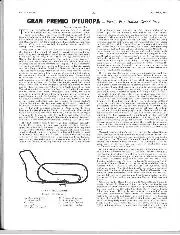Now things began to happen. Luigi finished a creditable 11th in the Targa Florio and scored a hat-trick of road-race wins, which brought him to the attention of Maserati, and in the Italian GP he shared a works car with Sergio Mantovani. They finished seventh. Two more victories in his own car won him the 2-litre Italian Sportscar Championship that year and Maserati promptly signed him up for 1954.
He and Giletti drove their 2-litre A6GCS to sixth overall in the Buenos Aires 1000Km. Back home he was fourth in the Tour of Sicily, a remarkable third in his very first Mille Miglia, won the Naples sportscars GP and finished second overall in the Targa Florio. Then he scored his first F1 win at Pescara, in a 250F. He finished the season with a fine third in the Tourist Trophy in a 2-litre Maserati and an even better second in the Spanish GP, behind Mike Hawthorn’s Ferrari.
In 1955 he was third in the Tour of Sicily; second at Naples, Bordeaux and Syracuse and then won the Supercortemaggiore 1000km at Monza, sharing a Maserati with Jean Behra.
The next year, Musso joined Scuderia Ferrari, as did Juan Fangio, Peter Collins and Eugenio Castellotti. In practice for their first race as team-mates the Argentine GP Luigi and Eugenio recorded exactly the same time in their Lancia-Ferraris. Musso did slightly better in the race, however, for Castellotti retired, whereas Fangio took over Luigi’s car and drove on to win. Thus Luigi was co-credited with what was to be his one and only championship victory.

At Maranello ahead of the 1956 Mille Miglia From left: Musso, Enzo Ferrari, Castellotti and Collins
Klemantaski Collection/Getty Images
In May he rolled his Ferrari on the third lap of the Nürburgring 1000Km, broke his arm, and was hors de combat until the Italian GP. This was annoying, but gave him plenty of time for gambling. “Musso loved racing, but even more he loved to gamble,” recalls Tavoni.
Musso’s enforced layoff gives us a convenient break in which to look at the career of his great rival. Proud and provincial, Eugenio Castellotti was swarthily handsome and also rather short, frequently wearing shoes with built-up heels.
“He was a very nice young man,” Tavoni says, “interested only in cars, racing and girls. He was born in 1930 in Lodi, near Milan, and his father was a rich landowner who died when he was 12 years old.”
In fact his father was not married to his mother, Angela, but he left her a large sum of money in his will, so when in 1951 Eugenio decided to go motor racing, he was able to buy a 2-litre Ferrari 166. In the Tour of Sicily he retired, but then finished sixth in class in the Mille Miglia. How easy it was in those days! Castellotti was not yet 21, had zero racing experience, yet began his career in two of the world’s greatest road races.

Castellotti and companions in 1955, ahead of the Mille Miglia
Klemantaski Collection/Getty Images
Next season he acquired a 2.7-litre 225S Ferrari and took fifth place in the Tour of Sicily. He then won the Pescara Gold Cup with the 166. The Monaco GP was for sportscars that year and Eugenio finished a fine second in the 225S, then won the Portuguese GP.
In 1953 success in road races brought him a Lancia contract, but the team failed dismally in the Nürburgring 1000Km and he did not get a drive. However, he made Lancia’s D23 perform impressively on the hills, and became Italian Mountain Champion. Finally, he went to Mexico for the Carrera PanAmericana, where Lancia swept to a tremendous 1,2,3 victory (Fangio, Taruffi, Castellotti).
Early in 1954 Lancia announced that it was going into Formula One. Ascari and Villoresi were signed to lead the team, with Castellotti as the junior driver. Unfortunately, the D50 GP car wasn’t ready until the very end of the season and Eugenio did not race it. He had a pretty disappointing year in Lancia’s sportscars, too, retiring at Sebring and in the Mille Miglia and Targa Florio. He won five climbs, though, and was Mountain Champion for the second year running.
He finally got his hands on the D50 Lancia in the 1955 Argentine GP. He retired there, but finished fourth in Turin and second at Pau, as he did in the Monaco GP, when while catching the Ferrari of the ultimate winner, Maurice Trintignant, he spun his chance away in the final laps.
Lancia then decided to withdraw from sportscar racing to concentrate on F1, so Eugenio raced Ferraris in endurance events. He put up bravura performances in the Mille Miglia and at Le Mans with the 4.4-litre 121LM, leading both races from the outset, but overtaxing his car in the process.









